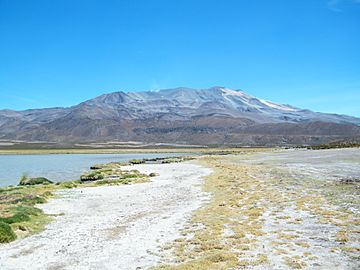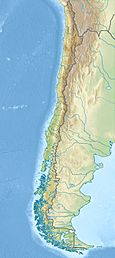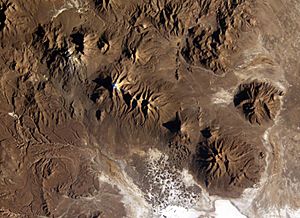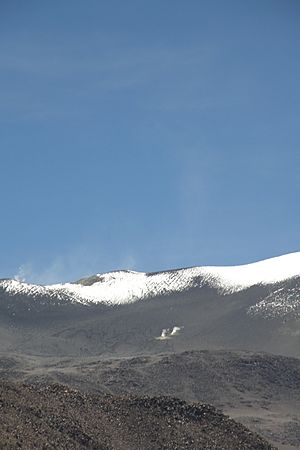Isluga facts for kids
Quick facts for kids Isluga |
|
|---|---|

Isluga volcano
|
|
| Highest point | |
| Elevation | 5,550 m (18,210 ft) |
| Geography | |
| Parent range | Andes |
| Geology | |
| Age of rock | Holocene |
| Mountain type | Stratovolcano |
| Volcanic arc/belt | Central Volcanic Zone |
| Last eruption | 1913 |
Isluga (pronounced is-LOO-gah) is a type of volcano called a stratovolcano. It is located in Colchane, Chile, about 7 kilometers (4.3 miles) west of the border with Bolivia. Isluga is part of a group of volcanoes that line up from east to west, which also includes Cabaray and Tata Sabaya. This volcano has a long top area and is found inside the Volcán Isluga National Park in Chile's Tarapacá Region.
Contents
Where is Isluga Located?
Isluga is in the commune of Colchane, which is part of the Iquique Province in the Tarapaca Region of Chile. The volcano is a key part of the Volcán Isluga National Park, which was created in 1985. You can reach the volcano using International Route 55.
Isluga is part of the Andean Volcanic Belt. This is a chain of volcanoes on the western side of South America. It forms where the Nazca plate (a large piece of Earth's crust) slides underneath the South American plate. This process is called subduction. Isluga is in a part of this belt called the Central Volcanic Zone. In the Tarapaca region, other volcanoes like Guallatiri, Parinacota, and Taapaca have also been active in recent geological times (the Holocene epoch).
What Does Isluga Look Like?
Isluga stands about 1,200 meters (3,900 feet) above its base. It has five craters, including a main crater that is 400 meters (1,300 feet) wide. This main crater is at the end of a snow-covered ridge at the top. The volcano itself is made up of lava domes and lava flows. These sit on top of older rock formations called ignimbrites, which formed during the Miocene epoch.
Scientists have found signs of different times when Isluga was active. For example, a large landslide of rock and debris, called a debris avalanche, happened on the northwestern side of Isluga. The newer parts of the volcano are built on top of this landslide. The crater area, which has active fumaroles (vents that release gas), has been covered by deposits from explosive eruptions caused by magma mixing with water (called phreatomagmatic activity). The northern ridge is covered by lava flows from the Holocene period.
There are also some interesting features around the volcano. North of Isluga is an older, eroded volcano called Quimsachatas. The top crater and the area below it on the southern side of Isluga still have faint fumarole activity. You can see yellow sulfur deposits there. These fumaroles mostly release water vapor.
When Did Isluga Erupt?
Isluga erupted in February 1878, right after a big earthquake in Tarapaca that same year. Huge amounts of lava flowed out, destroying towns like Carima, Cariquima, Chiapa, Libiza, and Sotoca. This eruption also came with strong earthquake activity in Cariquima. Other eruptions were reported in August 1863, a major one in 1868, and then in August 1869, 1877, and 1878. There were also smaller eruptions in 1863 and 1885.
The last time Isluga erupted was in 1913. However, scientists have noticed ongoing volcanic earthquake activity. Satellite images show that Isluga has some of the largest hot spots in the Andes mountains. There was also more fumarole activity reported in 2002–2003. Some of the earthquake activity might be linked to hot springs nearby. In 2005, a phreatic eruption (an eruption caused by steam, not new magma) was seen. It's not clear if this was connected to the 2005 Tarapacá earthquake that happened about six months earlier.
What is Isluga Made Of?
The lava from Isluga is mostly made of rock types called andesitic and trachyandesitic. These lavas contain between 56% and 61% silicon dioxide (SiO2). The andesitic lavas have many visible crystals (called phenocrysts) and are rich in potassium (2.7-3.6%). They also have moderate amounts of aluminium and high amounts of magnesium.
What is the Climate Like Around Isluga?
The weather around Isluga changes a lot depending on how high up you are.
- Between 2,800 and 4,000 meters (9,200-13,100 feet), it's like a desert. Temperatures range from below 0°C (32°F) to 10°C (50°F). Most of the rain (50-200 millimeters or 2-8 inches per year) falls in the summer.
- A similar climate is found on the eastern side of the mountains between 3,000 and 4,000 meters (9,800-13,100 feet), with 100-200 millimeters (4-8 inches) of rain per year.
- Above 4,000 meters (13,100 feet), there is steppe vegetation. Temperatures are usually between -5°C (23°F) and 5°C (41°F). About 150 millimeters (6 inches) of rain falls here each year, also mostly in summer.
- Above 5,200 meters (17,100 feet), there is snow all year round.
Mythology and Ancient History
Isluga is also known as Laram Qhawani. It is a sacred mountain for the people living in the village of Enquelca. They believe the volcano is a female spirit that brings health, wealth, and rain. It is thought to be married to another mountain spirit called Cabarray.
Even though no ancient remains have been found right on Isluga's summit, there is a triangular stone structure nearby. This structure looks like the patterns made when people offer gifts to spirits. One end of this triangle points towards Cerro Cariquima, which is another sacred mountain. Another ancient site was found at about 5,200 meters (17,056 feet) on the southern ridge. This site was likely used for protection from the wind and had a special space in its walls for rituals.
What are the Dangers from Isluga?
If Isluga erupts in the future, the main dangers would be:
- Contamination of water sources: Ash falling from the volcano could pollute underground water supplies (aquifers).
- Damage to farms: Ash could also destroy farmland, which is a big problem in the desert area around the volcano.
These issues are especially serious because water and good land are scarce in this dry region. Also, the unique cultural heritage of the area could be at risk, especially since not much is written down about it.
See also
 In Spanish: Volcán Isluga para niños
In Spanish: Volcán Isluga para niños
- List of volcanoes in Chile




